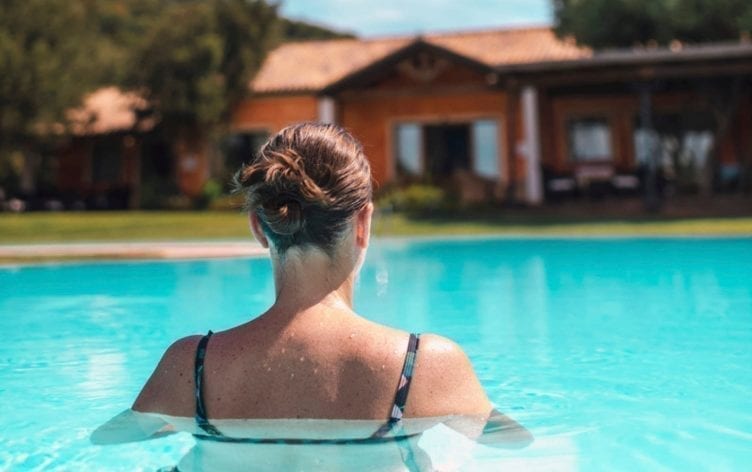
Most people think of swimming or even pool running as the main way to exercise in a pool, but walking can actually be a great option. As a go-to workout for many physical therapists and trainers, pool walking can be as easy or as difficult as needed. Here, a look at how pool walking can be a beneficial part of your exercise routine and tips for getting the most out of it:
IT’S GREAT FOR ALL ABILITY LEVELS
The workout’s versatility makes it a beneficial option for people of all fitness levels. “It can be as simple as walking back and forth in the shallow end of the pool or as complex as a high-intensity interval training session with coaches, special aqua gear and motorized underwater treadmills,” explains physical therapist Morgan Fielder. Pool walking can be done in shallow water with feet touching the bottom of the pool or in deeper water with a flotation belt. Weights and resistance-training exercises are also often incorporated into pool-walking workouts.
Water workouts offer different benefits than land workouts, notes Kim Evans, lead trainer at Spring Lake Fitness and Aquatic Center. Since water is buoyant, people with joint issues are usually more comfortable working out in the water. This also makes it a good option for those who have high training volumes in other sports, like running and weightlifting. Water also naturally provides resistance to help tone muscles and is good for people with circulation issues.
IT’S AN EFFECTIVE WAY TO IMPROVE CARDIO
“Pool-walking workouts can be as long or short as you like, but 20–45 minutes is a good length of time to get your heart rate up and in the zone that allows you to work on cardiovascular health,” says Evans. “Because of the pressure of the water, your heart rate is lower, so people can push themselves harder than on land and not get their heart rate up too high.”
IT’S GOOD FOR THOSE WITH INJURIES
Water workouts are an amazing way to work on stability and balance, which is beneficial for everyone, but comes in especially handy for those recovering from injury. “The water really helps as an assist with range of motion, and you can push the limits of balance in the water. The worst that can happen is you get wet, whereas on land you could fall,” notes Evans.
HOW TO GET THE MOST OUT OF POOL WALKING
1. BUILD DURATION OVER TIME
Because pool walking may feel easy in the moment, it’s common to overdo it. “It’s always best to start easy and gradually build up your duration, intensity and frequency,” says Fielder. “Make sure to record your workouts in a journal, along with how you felt afterwards.” This can help you determine whether your pool workouts are working for you and how you can adjust to see the most success. Remember: “Any good fitness program takes at least six weeks of dedicated effort to make a lasting transformation.”
2. TAILOR YOUR WORKOUT TO YOUR FITNESS LEVEL
Though pool walking is often used to rehabilitate from injuries, that doesn’t mean it can’t be used as a tool for more advanced athletes. “When I competed in NCAA Division I track and field in college, our coach put us in the pool once a week to help mitigate all the lower-body injuries we sustained running at such a high level,” explains Fielder.
Make pool walking as difficult or easy as needed using the guidelines below:
To make it harder:
- Increase the duration
- Increase your speed
- Go deeper in the pool
- Walk against a current
- Wear special webbed gloves that make it harder for you to pump your arms through the water
- Perform Tabata-style high-intensity sessions
To make it easier:
- Do a shorter workout
- Slow your pace
- Avoid water with a current
- Stay in the shallow area
- Take more frequent rest breaks
3. WORK ON YOUR BALANCE
“I recommend people do lots of balance work in the pool,” says Evans. Standing on one foot, doing one-legged exercises, moving from side to side and leaning forward or backward as you walk can help improve your stability on land. This is especially good for anyone with an injury who cannot do balance work on land or those who want to improve their balance in general or for a specific sport, like skiing or surfing.
4. USE POOL WEIGHTS
Adding weights to your pool workout can have major benefits, whether you simply walk with them in your hands or do resistance-training exercises. “Your range of motion in the pool is much larger because the water supports you,” explains Evans.That means you might be able to sit deeper in a squat or reach further overhead in the water than you might be able to otherwise.
5. TRY IT IN A LAKE OR OCEAN
The advantages of exercising in the great outdoors are well-documented, so if you can, take your water-walking workout to a natural body of water. “I live near Lake Michigan, and in the summer, I will wade out to the first sandbar and walk through the water,” says Evans. “It’s a tough workout, as the water is about thigh-deep and it really drags on your legs. I have done the same in Florida and in the Gulf of Mexico. It’s really nice in the summer when the weather is so hot.” Even if you don’t live near a body of water it can be a great activity to try when traveling.







